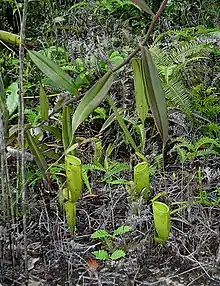Nepenthes × trichocarpa
Nepenthes × trichocarpa (/nɪˈpɛnθiːz ˌtrɪkoʊˈkɑːrpə/; from Greek: trikho- "hair, thread", and -carpus "fruit"), the dainty pitcher-Plant,[2] is a common natural hybrid involving N. ampullaria and N. gracilis. It was originally thought to be a distinct species and was described as such.

| Nepenthes × trichocarpa | |
|---|---|
 | |
| Upper pitcher of Nepenthes × trichocarpa from Sumatra. | |
| Scientific classification | |
| Kingdom: | Plantae |
| Clade: | Tracheophytes |
| Clade: | Angiosperms |
| Clade: | Eudicots |
| Order: | Caryophyllales |
| Family: | Nepenthaceae |
| Genus: | Nepenthes |
| Species: | N. × trichocarpa |
| Binomial name | |
| Nepenthes × trichocarpa Miq. (1858) | |
| Synonyms | |
| |
B. H. Danser included this plant in his 1928 monograph on the genus Nepenthes. He described the plant as a climbing stem cylindrical in cross-section, and pitchers of the rosettes shortly incurved from the tendril and ovate in form. Both lower and upper pitchers can be up to 8 cm tall, widest at 1/3 of the height, up to 4 cm wide, with two fringed wings over the whole length.
The colour of the pitchers ranges from green to spotted or striped with red or yellow, forming wonderful carpets on the forest floor and dainty upper pitchers scrambling up supporting shrubs and trees.
Nepenthes × trichocarpa is found throughout the lowlands of Peninsular Malaysia, Borneo, Singapore and Sumatra, usually in the company of its parent species, N. ampullaria and N. gracilis.[3][4][5][6][7] It has also been recorded from southern Thailand[8] and from smaller surrounding islands such as Natuna.[9]
Infraspecific taxa
- Nepenthes trichocarpa var. erythrosticta Miq. (1861)
References
- von Arx, B., J. Schlauer & M. Groves 2001. "CITES Carnivorous Plant Checklist" (PDF). Archived from the original (PDF) on 2008-05-13. The Cromwell Press, United Kingdom.
- Phillipps, A. & A. Lamb 1996. Pitcher-Plants of Borneo. Natural History Publications (Borneo), Kota Kinabalu.
- Adam, J.H., C.C. Wilcock & M.D. Swaine 1989. Ecology and taxonomy of Bornean Nepenthes. University of Aberdeen Tropical Biology Newsletter 56: 2–4.
- Adam, J.H., C.C. Wilcock & M.D. Swaine 1992. "The ecology and distribution of Bornean Nepenthes" (PDF). Archived from the original (PDF) on 2011-07-22. Journal of Tropical Forest Science 5(1): 13–25.
- McPherson, S.R. & A. Robinson 2012. Field Guide to the Pitcher Plants of Borneo. Redfern Natural History Productions, Poole.
- McPherson, S.R. & A. Robinson 2012. Field Guide to the Pitcher Plants of Peninsular Malaysia and Indochina. Redfern Natural History Productions, Poole.
- McPherson, S.R. & A. Robinson 2012. Field Guide to the Pitcher Plants of Sumatra and Java. Redfern Natural History Productions, Poole.
- (in Italian) Catalano, M. 2010. Nepenthes della Thailandia: Diario di viaggio. Prague.
- (in Indonesian) Mansur, M. 2012. Keanekaragaman jenis tumbuhan pemakan serangga dan laju fotosintesisnya di Pulau Natuna. [Diversity on insectivorous plants and its photosynthetic rate in Natuna Island.] Berita Biologi 11(1): 33–42. Abstract Archived 2013-09-21 at the Wayback Machine
Further reading
- Clarke, C.M. (1997). Nepenthes of Borneo. Kota Kinabalu: Natural History Publications. p. 150. ISBN 983-812-015-4.
- Clarke, C.M. 2006. Introduction. In: Danser, B.H. The Nepenthaceae of the Netherlands Indies. Natural History Publications (Borneo), Kota Kinabalu. pp. 1–15.
- (in Indonesian) Enjelina, W. 2012. Analisis hibrid alam kantung semar (Nepenthes) di Bukit Taratak Kabupaten Pesisir Selatan Sumatera Barat dengan teknik RAPD. M.Sc. thesis, Andalas University, Padang.
- Hwee, K.C. 1996. Carnivorous plants and sites in Singapore. Bulletin of the Australian Carnivorous Plant Society, Inc. 15(4): 12–15.
- (in Indonesian) Mansur, M. 2001. "Koleksi Nepenthes di Herbarium Bogoriense: prospeknya sebagai tanaman hias" (PDF). Archived from the original (PDF) on 2012-03-19. In: Prosiding Seminar Hari Cinta Puspa dan Satwa Nasional. Lembaga Ilmu Pengetahuan Indonesia, Bogor. pp. 244–253.
- (in Indonesian) Mansur, M. 2007. Keanekaragaman jenis Nepenthes (kantong semar) dataran rendah di Kalimantan Tengah. [Diversity of lowland Nepenthes (kantong semar) in Central Kalimantan.] Berita Biologi 8(5): 335–341. Abstract
- Shivas, R.G. 1983. Nepenthes trichocarpa — a natural hybrid. Nature Malaysiana 8(2): 24–25.
- Shivas, R.G. 1984. Pitcher Plants of Peninsular Malaysia & Singapore. Maruzen Asia, Kuala Lumpur.
- (in Indonesian) Srirahayu 2010. Kajian fertilitas hibrid alami pada populasi Nepenthes di Bukit Taratak, Kenagarian Surantih, Kecamatan Sutera, Kabupaten Pesisir Selatan. Thesis, Andalas University, Padang. Abstract
- Teo, L.L. 2001. Study of natural hybridisation in some tropical plants using amplified fragment length polymorphism analysis. M.Sc. thesis, Nanyang Technological University, Singapore.
